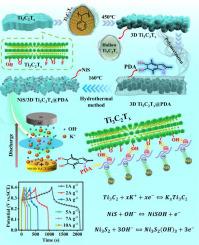释放 3D Ti3C2Tx 的能量:电化学储能领域的突破
IF 13.2
1区 工程技术
Q1 ENGINEERING, CHEMICAL
引用次数: 0
摘要
TiCT 纳米片容易堆叠,这给固定活性材料带来了挑战,从而限制了存储设备的性能。将二维 TiCT 集成到三维(3D)结构中被认为是实现超高性能超级电容器的重要但具有挑战性的方法之一。在本研究中,我们报告了利用牺牲模板法将 TiCT 制备成三维网络互连结构,并以聚多巴胺 (PDA) 作为封装涂层材料。随后,TiCT/PDA 复合材料与作为电极材料的 NiS 相结合。三维 TiCT 结构可有效阻碍 TiCT 的堆叠,而 PDA 表面的 -OH 基团可与三维 TiCT 的官能团形成非共价相互作用,防止其氧化并加速电子转移。PDA 中的氮原子可以锚定 Ni-S 以避免其脱离,从而使制备的复合材料具有更好的电化学性能。作为电极材料的 Ni-S/3D TiCT@PDA 具有 281.8 mAh/g (1 A/g) 的高比电容。以 Ni-S/3D TiCT @PDA 为阳极材料的不对称超级电容器在功率密度为 1600 W kg 的情况下,能量密度高达 35.5 W kg,而且循环稳定性极佳,在 3 A/g 的条件下,循环保持率为 98.83 %,循环 10,000 次的容量效率为 84.98 %。综上所述,Ni-S/3D TiCT @PDA 材料在超级电容器领域具有巨大的发展潜力。本文章由计算机程序翻译,如有差异,请以英文原文为准。

Unleashing the power of 3D Ti3C2Tx: A breakthrough in electrochemical energy storage
The tendency of TiCT nanosheets to be stacked makes it challenging to immobilize the active material, thus limiting the performance of the storage device. Integrating two-dimensional TiCT into three-dimensional (3D) structures is considered one of the important yet challenging approaches to realize ultra-high-performance supercapacitors. In this study, we report the preparation of TiCT into a 3D network interconnection structure using the sacrificial template method, with polydopamine (PDA) serving as a coating material for encapsulation. Subsequently, the TiCT/PDA composite is combined with NiS as an electrode material. The 3D TiCT structure effectively hinders the stacking of TiCT, while the –OH groups on the surface of PDA form non-covalent interactions with the functional groups of 3D TiCT, preventing its oxidation and accelerating electron transfer. The nitrogen atom in PDA can anchor Ni-S to avoid its detachment, which leads to better electrochemical properties of the prepared composites. Ni-S/3D TiCT@PDA as an electrode material had a high specific capacitance of 281.8 mAh/g (1 A/g). The asymmetric supercapacitor using Ni-S/3D TiCT @PDA as the anode material achieved a high energy density of 35.5 W kg at 1600 W kg power density, and excellent cycling stability, possessing 98.83 % cycle retention and 84.98 % capacity efficiency at 3 A/g for 10,000 cycles. In summary, it can be seen that Ni-S/3D TiCT @PDA materials have great potential for development in supercapacitors.
求助全文
通过发布文献求助,成功后即可免费获取论文全文。
去求助
来源期刊

Chemical Engineering Journal
工程技术-工程:化工
CiteScore
21.70
自引率
9.30%
发文量
6781
审稿时长
2.4 months
期刊介绍:
The Chemical Engineering Journal is an international research journal that invites contributions of original and novel fundamental research. It aims to provide an international platform for presenting original fundamental research, interpretative reviews, and discussions on new developments in chemical engineering. The journal welcomes papers that describe novel theory and its practical application, as well as those that demonstrate the transfer of techniques from other disciplines. It also welcomes reports on carefully conducted experimental work that is soundly interpreted. The main focus of the journal is on original and rigorous research results that have broad significance. The Catalysis section within the Chemical Engineering Journal focuses specifically on Experimental and Theoretical studies in the fields of heterogeneous catalysis, molecular catalysis, and biocatalysis. These studies have industrial impact on various sectors such as chemicals, energy, materials, foods, healthcare, and environmental protection.
 求助内容:
求助内容: 应助结果提醒方式:
应助结果提醒方式:


